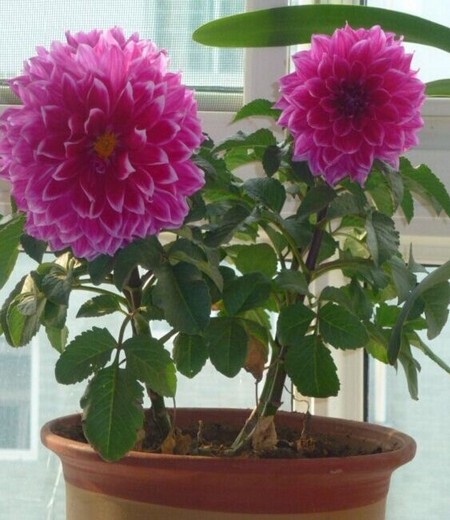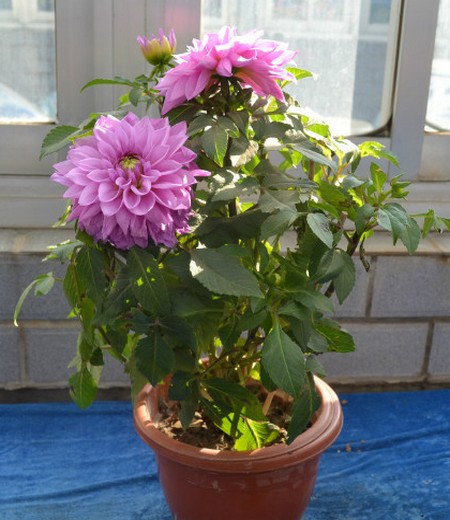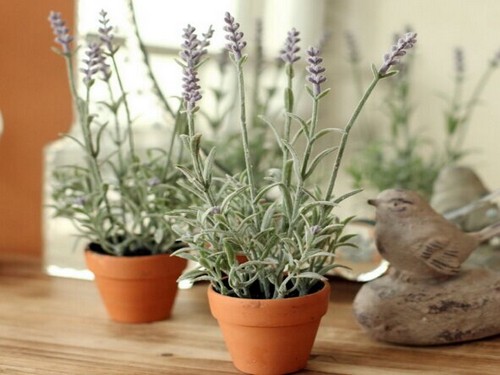How do potted dahlias grow? Dahlia planting method
The key to the growth of potted dahlias is to strengthen the management of plant pot soil, give sufficient light, apply water and fertilizer frequently, and carry out timely shaping and pruning. Dahlia is one of the most diverse species of flowers in the world, with a symbol of happiness, many people will choose to grow in courtyards, balconies and other places at home. Let's take a look at the planting methods of dahlias.

Potted soil:
Dahlia is suitable for sandy loam which is loose, rich in humus and good drainage. Potted dahlia planting soil is generally suitable for vegetable garden soil (50%), rotten leaf soil (20%), sandy soil (20%) and dried dung (10%). The consolidated soil is easy to cause waterlogging and rotting roots, which can not be used. In the daily management, loosen the soil in time and eliminate waterlogging in the basin, because the fleshy root of Dahlia rotted when there was too much water content in the soil and poor air permeability.
Lighting:
Dahlia likes light and is not tolerant to shade. If it is placed in the shade for a long time, it will grow poorly, the root system is weak, the leaves are thin and the stems are thin, the flowers are small and light, and some even cannot blossom. Therefore, potted dahlias should be placed in a sunny place. There is sufficient light in the leaves, which requires more than 6 hours of light a day, so that the plants are strong and the flowers are large and plump. If the sunshine is less than 4 hours a day, the branching of stems and leaves and the formation of buds will be affected to a certain extent, especially if there is little sunshine, the flowering is not smooth, the growth of stems and leaves is poor, and it is easy to get sick.
Watering:
Dahlia like water but avoid stagnant water, both afraid of waterlogging and drought, this is because the big flower is fleshy root, too much watering root is easy to rot. However, Dahlia has luxuriant branches and leaves, large evaporation, and needs more water, if it can not replenish water in time after wilting due to lack of water, and then exposed to sunlight, the edge of the light leaf will be scorched, and the heavy basal leaf will fall off. Watering should grasp the principle of "dry and thoroughly irrigated". In general, water is limited in the early growth stage, and it can be watered once a day on a sunny day, keeping the soil slightly moist, and it is not appropriate to be too dry and wet. In the later stage of growth, the branches and leaves are luxuriant and consume more water. Sunny or northerly weather. Note that it is easy to lack water at noon or evening, and the amount of water should be increased appropriately.
Fertilization:
Dahlia is a kind of fertilizer-loving flower, which is usually applied with dilute liquid fertilizer every 10-15 days from the seedlings. Apply it every 7-10 days after budding. Stop watering when the flower buds are transparent. It is not suitable to apply fertilizer when the temperature is high. The amount of fertilizer applied depends on the growth of the plant. Where the leaf color is light and barren, it is the phenomenon of lack of fertilizer; on the contrary, if the fertilizer is excessive, the leaf edge is scorched or the leaf tip is yellow, and the leaf is thick and dark green, which is the performance of proper fertilization. The concentration of fertilizer should be increased each time, so that the stalk can be sturdy.
Shaping and trimming:
The pruning of potted dahlias should be flexibly controlled according to the variety. In general, single-plant plastic surgery is used for large varieties and 4-book plastic surgery for medium-sized varieties. Single plant plastic surgery is to retain the terminal bud, remove all the bowels, so that nutrition is concentrated, forming a low plant, large flower type of single plant Dahlia. 4 this dahlia is a potted dahlia with 4 stems and 4 flowers, which is made by coring the seedling and keeping the two basal nodes to form 4 lateral branches, with terminal buds on each side.
Insert pole support plant:
The stem of Dahlia is empty and brittle, and it is easy to be broken by the wind, so it should be supported by bamboo planting in time, which can also avoid the bending of branches and improve the ornamental value of potted plants. When the plant is more than 30 cm tall, a small bamboo should be inserted next to each branch and tied with hemp skin (or string); as the plant grows taller and taller, a longer bamboo should be replaced in time, and the final bamboo should be placed on the lower part of the bud.
Safe to survive the winter: Dahlia is not resistant to cold (mainly because the root can not be frozen). In November, when the branches and leaves withered, the aboveground parts should be cut off, moved indoors and preserved in the original pot. The root tuber can also be taken out and hung for 1-2 days and buried in indoor moist sand with a temperature of no more than 5 degrees, and then planted in the pot the following spring.
If you want to cultivate Dahlia well, you need to master its four characteristics:
(1) like to be moist and afraid of waterlogging. Dahlias are afraid of drought and avoid stagnant water. This is because dahlias are fleshy roots, which are easy to rot if they are watered too much. But its leaves are large, grow luxuriantly, and need more water. If the lack of water and wilting can not replenish water in time, after sunlight, the edge of the light leaf will be scorched, and the heavy leaf will fall off. Therefore, watering should grasp the principle of "dry and thoroughly irrigated".
(2) like to be fertile and afraid to be excessive. Planting dahlias should choose fertile and loose soil, in addition to applying basic fertilizer, but also topdressing. Usually from the middle to the end of July until flowering, thin liquid fertilizer is applied every 7-10 days, and the concentration of fertilization should be gradually increased to make the stem grow stronger and stronger, and the leaf color dark green and stretch.
(3) like sunshine and fear shade. Dahlias like to be sunny. If placed in the shade for a long time, the growth is poor, the root system is weak, the leaf is thin and the stem is thin, the flower is small and light, and even cannot blossom. Only when it is planted in a sunny place, can the plant grow healthily and produce bright flowers.
(4) like cool and afraid of heat. Dahlia blossoms like cool climate, the temperature is about 20 ℃, the growth is the best. Planting in North China and other places can grow well from late spring to late autumn. But it is afraid of the hot summer sun, especially the sunny exposure after the rain, at this time should be a little shade, the growth is better.
Time: 2019-06-01 Click:
- Prev

Culture methods and matters needing attention of Dahlia
Dahlia is native to Mexico. Mexicans regard it as a symbol of generosity and richness, so they respect it as the national flower. At present, it has been planted in most countries in the world, and new varieties have been selected from time to time. According to statistics, there are more than 30,000 dahlia varieties, which is one of the species with the largest number of flower varieties in the world.
- Next

How to raise lavender in potted plants
Lavender is very suitable, it not only has a beautiful appearance, has a high ornamental value, it can also be used in pharmaceutical, lavender pillows, extract flavors to make perfume and so on. In order to give a healthy environment at home, many friends also plant lavender in their own homes. How to plant lavender seeds
Related
- Fuxing push coffee new agricultural production and marketing class: lack of small-scale processing plants
- Jujube rice field leisure farm deep ploughing Yilan for five years to create a space for organic food and play
- Nongyu Farm-A trial of organic papaya for brave women with advanced technology
- Four points for attention in the prevention and control of diseases and insect pests of edible fungi
- How to add nutrient solution to Edible Fungi
- Is there any good way to control edible fungus mites?
- Open Inoculation Technology of Edible Fungi
- Is there any clever way to use fertilizer for edible fungus in winter?
- What agents are used to kill the pathogens of edible fungi in the mushroom shed?
- Rapid drying of Edible Fungi

